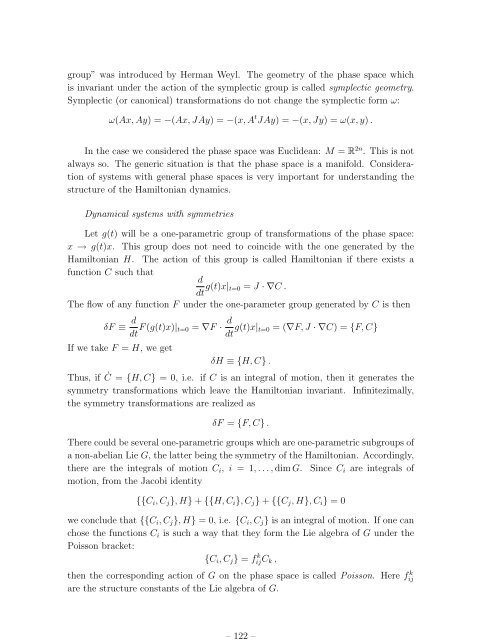Lectures on String Theory
Lectures on String Theory
Lectures on String Theory
You also want an ePaper? Increase the reach of your titles
YUMPU automatically turns print PDFs into web optimized ePapers that Google loves.
– 122 –<br />
group” was introduced by Herman Weyl. The geometry of the phase space which<br />
is invariant under the acti<strong>on</strong> of the symplectic group is called symplectic geometry.<br />
Symplectic (or can<strong>on</strong>ical) transformati<strong>on</strong>s do not change the symplectic form ω:<br />
ω(Ax, Ay) = −(Ax, JAy) = −(x, A t JAy) = −(x, Jy) = ω(x, y) .<br />
In the case we c<strong>on</strong>sidered the phase space was Euclidean: M = R 2n . This is not<br />
always so. The generic situati<strong>on</strong> is that the phase space is a manifold. C<strong>on</strong>siderati<strong>on</strong><br />
of systems with general phase spaces is very important for understanding the<br />
structure of the Hamilt<strong>on</strong>ian dynamics.<br />
Dynamical systems with symmetries<br />
Let g(t) will be a <strong>on</strong>e-parametric group of transformati<strong>on</strong>s of the phase space:<br />
x → g(t)x. This group does not need to coincide with the <strong>on</strong>e generated by the<br />
Hamilt<strong>on</strong>ian H. The acti<strong>on</strong> of this group is called Hamilt<strong>on</strong>ian if there exists a<br />
functi<strong>on</strong> C such that<br />
d<br />
dt g(t)x| t=0 = J · ∇C .<br />
The flow of any functi<strong>on</strong> F under the <strong>on</strong>e-parameter group generated by C is then<br />
δF ≡ d dt F (g(t)x)| t=0 = ∇F · d<br />
dt g(t)x| t=0 = (∇F, J · ∇C) = {F, C}<br />
If we take F = H, we get<br />
δH ≡ {H, C} .<br />
Thus, if Ċ = {H, C} = 0, i.e. if C is an integral of moti<strong>on</strong>, then it generates the<br />
symmetry transformati<strong>on</strong>s which leave the Hamilt<strong>on</strong>ian invariant. Infinitezimally,<br />
the symmetry transformati<strong>on</strong>s are realized as<br />
δF = {F, C} .<br />
There could be several <strong>on</strong>e-parametric groups which are <strong>on</strong>e-parametric subgroups of<br />
a n<strong>on</strong>-abelian Lie G, the latter being the symmetry of the Hamilt<strong>on</strong>ian. Accordingly,<br />
there are the integrals of moti<strong>on</strong> C i , i = 1, . . . , dim G. Since C i are integrals of<br />
moti<strong>on</strong>, from the Jacobi identity<br />
{{C i , C j }, H} + {{H, C i }, C j } + {{C j , H}, C i } = 0<br />
we c<strong>on</strong>clude that {{C i , C j }, H} = 0, i.e. {C i , C j } is an integral of moti<strong>on</strong>. If <strong>on</strong>e can<br />
chose the functi<strong>on</strong>s C i is such a way that they form the Lie algebra of G under the<br />
Poiss<strong>on</strong> bracket:<br />
{C i , C j } = f k ijC k ,<br />
then the corresp<strong>on</strong>ding acti<strong>on</strong> of G <strong>on</strong> the phase space is called Poiss<strong>on</strong>. Here f k ij<br />
are the structure c<strong>on</strong>stants of the Lie algebra of G.

















